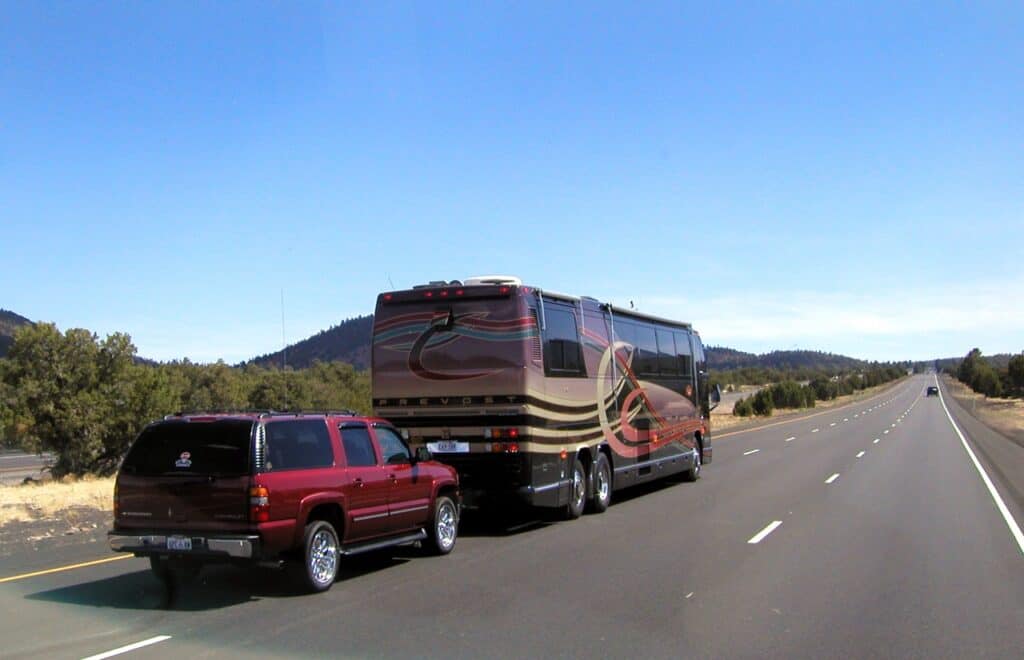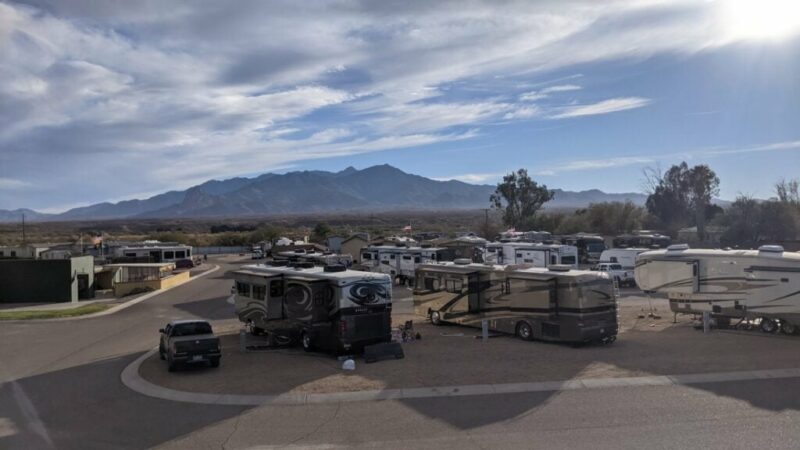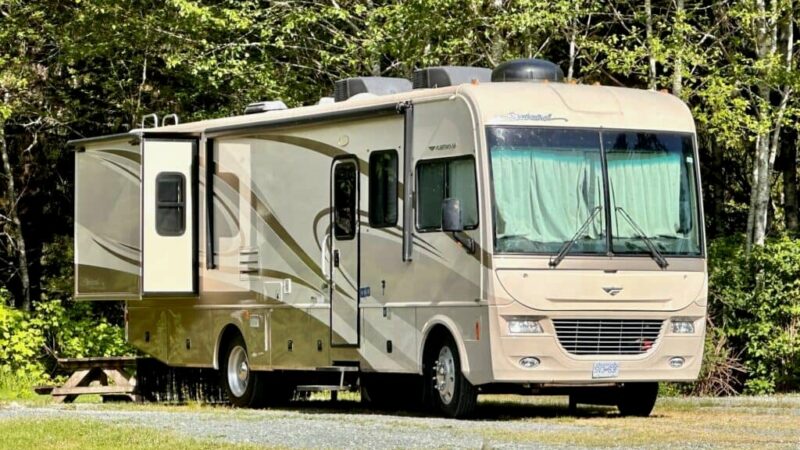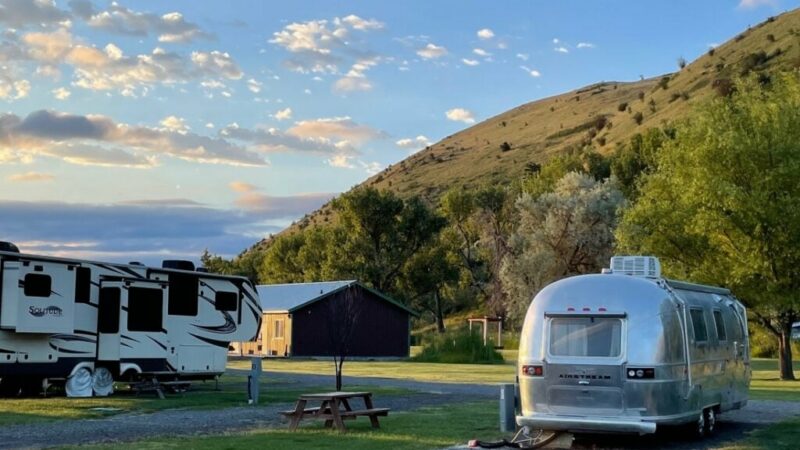2024 Dinghy Towing Guide: An RV LIFE Exclusive
Why Consider Dinghy Towing A Vehicle Behind Your Motorhome?
If you drive a larger motorhome, you know what a hassle it can be to go sightseeing or even grocery shopping. What is normally a simple simple errand can become an exercise in navigation and finding parking. Bringing a passenger vehicle along for the ride makes it a lot easier to run errands or explore area attractions. The three methods of doing this include trailer towing, dolly towing, and dinghy towing (or flat towing). By far the easiest way to do this is by towing four wheels down, otherwise known as dingy towing.
This is largely because towing with four wheels on the pavement doesn’t require acquiring and dealing with a lot of extra equipment (though there is some of that). With dingy towing, you just hook up your vehicle, set up your auxiliary braking system and signal lights and go. When you arrive at a destination, you can unhook and have full use of your vehicle within minutes. In this article you’ll learn everything you need to know about how to safely flat tow a vehicle behind a motorhome.
Find out your motorhome’s towing capacity
Overloading your RV chassis by trying to tow too much is unsafe and can result in shortening your RV’s lifespan dramatically. So before you can tow any vehicle behind your you’ll need to know how much weight your RV can safely tow. This information will be in your chassis manual, but is often on a label somewhere on the RV.
A motorhome’s tow rating is defined as:
“The maximum weight limit that can safely be towed by your specific vehicle. This weight is calculated by adding the RV’s gross vehicle weight (GVW) with weight of all passengers, cargo, and liquids in your tow vehicle.” — Lichtsinn RV
Choosing a vehicle to dinghy-tow behind a motorhome
Like it or not, you might not be able to tow the vehicle you already have behind your motorhome. That’s because many modern vehicles just don’t have the the right transmission for dinghy towing. Typically, you’ll need either a vehicle with rear-wheel drive and a manual transmission or a four-wheel drive truck or SUV with a transfer case that can be placed in neutral. If you try to flat tow any other vehicle, you could cause expensive damage to the drivetrain.
Exclusive list of 2024 manufacturer-approved dinghy vehicles
All models vehicles listed below are the 2024 models. Other, older models may be dinghy-towable, but you’ll need to check with the manufacturer beforehand to make sure. Do NOT assume because one year is dinghy-towable that another will be.
BUICK
Encore GX AWD (Only)
CADILLAC
Escalade 4WD (with a two-speed transfer case that has an N and a 4WD Low setting)
CHEVROLET
Blazer
Colorado 4WD (with a two-speed transfer case that has an N and a 4WD Low setting)
Equinox
Silverado 1500 4WD (with a two-speed transfer case that has an N and a 4WD Low setting)
Silverado 2500/3500 HD 4WD (with a two-speed transfer case that has an N and a 4WD Low setting)
Suburban 4WD (with a two-speed transfer case that has an N and a 4WD Low setting)
Tahoe 4WD (with a two-speed transfer case that has an N and a 4WD Low setting)
TRAX
Trailblazer (AWD Vehicles Only)
Traverse Limited
DODGE
Durango (AWD Models with Two-Speed Transfer Case Only)
FORD
Bronco (not Bronco Sport models)
Ford Edge 2.7L Ecoboost Models Only
Ford Escape Full Hybrid Electric Vehicle (FHEV)/Plug-in Hybrid Electric Vehicle (PHEV) Models Only
Expedition 4×4 Only
F-150 4WD
Maverick Hybrid Electric Vehicle (HEV) Model Only
2024 Super Duty 4WD
GMC
Canyon/Canyon Denali 4WD (with a two-speed transfer case that has an N and a 4WD Low setting)
Sierra/Sierra Denali 1500 4WD (with a two-speed transfer case that has an N and a 4WD Low setting)
Sierra/Sierra Denali 2500HD, 3500HD 4WD (with a two-speed transfer case that has an N and a 4WD Low setting)
Yukon/Yukon XL/Denali 4WD (with a two-speed transfer case that has an N and a 4WD Low setting)
JEEP
Gladiator 4WD Models Only
Grand Cherokee Four-Wheel Drive Models With 4WD LOW
Wagoneer/Grand Wagoneer Four-Wheel Drive Models With 4WD LOW
Wrangler 4WD Models Only
LINCOLN
Corsair Plug-in Hybrid Electric Vehicle (PHEV) Only
Lincoln Nautilus Full Hybrid Electric Vehicle (FHEV) Only
Navigator 4×4 Only
NISSAN
Sentra with Manual Transmission Only
Versa Sedan with Manual Transmission Only
Z with Manual Transmission Only
RAM Trucks
1500 4WD
2500 4WD
3500 4WD
Certain vehicles have restrictions on the speeds at which they can safely be towed. Many have special instructions that are required by the manufacturer before you hit the road (or while you’re in route). Not only that, but only certain versions of some of the models listed can be flat towed.
It’s essential to check your prospective towed vehicle’s owner’s manual for towing instructions before you tow it. You’ll find a chapter about how to tow in the manual that comes with every vehicle. It may refer to “dinghy towing,” “flat-towing,” or even “recreational towing.”
Dinghy-towing Set Up
In addition to a hitch with a receiver that can handle the weight of a dinghy vehicle, you’ll need other specific equipment:
- Base plate
- Tow bar
- Safety cables or chains
- Breakaway switch and cable
- Auxiliary braking system
- Wiring harness for lights OR wireless magnetic LED lights
- Rock guard to protect your dinghy vehicle from road debris (optional)
Base Plates
Mounting a tow bar base plate on your dinghy vehicle provides a solid attachment point for the tow bar. It’s not a difficult job if you’re handy and have the right tools. Some base plates require cutting the vehicle’s trim. If you will have the towing base plate professionally installed by an RV technician or mechanic, it’s important to shop around. Some of them will do this job for you, while others won’t. Dinghy-towing base plates are application-specific for vehicles and tow bars.
Some of the most popular base plates for dinghy towing are from:
Tow Bars
The tow bar connects the toad to the motorhome. Tow bars for flat towing have sufficient flex to hitch and unhitch the vehicle easily, and are designed to lock into place while you tow. This is so the dinghy vehicle doesn’t creep up on the motorhome when you slow down or stop. Most tow bars come with a set of removable tabs that lock into the baseplate. However, if you don’t want tabs, Demco makes a tabless baseplate for it’s towbar.
Towbars are often packaged with the baseplate. If the vehicle you intend to tow already has a baseplate for towing but you don’t know which one it is, don’t panic. You won’t necessarily need to swap it out for a new one. However, you’ll need to find out which towbar it was designed to work with by taking note of its design and components. Then carefully compare it to images of different baseplates online. After that, you can decide if the towbar that matches it is the one you want or if you’d rather go with a different towbar and change the baseplate. Here’s a list of links to popular tow bar systems:
Tow bars are available with weight capacities that range between 5,000 and 10,000 pounds. Your choice of tow bar should depend in part on the vehicle you intend to tow. Some tow bars can be folded up, out of the way behind the motorhome when not in use. That way, it’s unnecessary to remove them when they aren’t in use.
Cables
Preparing for the unexpected can prevent disasters from happening. It’s essential to have a set of safety cables or chains just in case your toad becomes detached while you’re driving.
Breakaway Switches
A breakaway switch will ensure the brakes in your dinghy vehicle are applied if it becomes detached while being towed. The breakaway switch mounts on the baseplate and is wired to the brake controller in the towed vehicle. Many states (and provinces in Canada) require you to have one.
Auxiliary Braking Systems
A portable or wired braking system in your towed vehicle will help it to stop evenly and smoothly whenever the brakes are applied in the motorhome. Braking systems are required by law in most places in the US and Canada. There are several popular brands of braking systems for flat towing. The one you choose will depend largely on your motorhome, the vehicle you’re towing, and your personal preferences. Some popular examples include those from:
Rock Guards
Motorhome tires can kick up rocks and other debris, resulting in damage to the towed vehicle. Rock guards hang beneath the rear of the motorhome, keeping rocks and debris under the motorhome where they won’t harm anything.
There are three types of rock guards: brush, split, and solid. Each type has advantages and disadvantages, so the type you choose for your RV will depend on your own needs and preferences. Click here to learn more about RV rock guards.
Signal/Tail Lights
There are two options for setting up tail lights. You can install a wiring harness that connects your vehicle tail lights to the 6 or 7-pin connector located near the hitch on your RV. The easiest option is to use wireless LED tail lights that mount directly onto a vertical section on the back of the towed vehicle using strong magnets.
Wireless LED tail lights tell other drivers what you intend to do by repeating what the RV tail lights are doing. They work by receiving a signal from a transmitter that plugs into the 6 or 7 pin connector. Look for rechargeable wireless tail lights like these ones from Hendo. Also, many of the same dinghy-accessory manufacturers listed above carry some version of one, the other, or both.
So, is Dinghy-towing Worth the Effort?
Of course it is! A dinghy vehicle makes RV living even more enjoyable. You don’t have to break camp any time you want to explore, and you have a passenger vehicle for trips to the grocery store, local attractions, and more. Dinghy towing is easier than you think. With a good set up, your dinghy vehicle will track behind your RV without any trouble. Getting the right set up without cutting corners is crucial to a positive experience.
The post 2024 Dinghy Towing Guide: An RV LIFE Exclusive appeared first on RV LIFE.
Source: https://rvlife.com/2024-dinghy-towing-guide-an-rv-life-exclusive/







